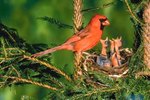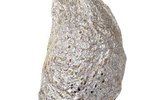
In a letter published in an 1867 issue of “The Field,” Alfred R. Wallace noted that thrushes, robins and “any of the warblers,” would eagerly predate upon caterpillars. In fact, caterpillar consumption is commonplace among birds, and even seed eating species may snack on caterpillars when they get the chance to. This predatory pattern is understandable as caterpillars are very nutritious and many lack effective defenses.
Caterpillar Connoisseurs of the New World
Common backyard birds, such as American robins (Turdus migratorious), red-eyed vireos (Vireo olivaceus) and Carolina wrens (Thryothorus ludovicianus), are very fond of caterpillars. Yellow warblers (Dendroica petechial) greedily consume larval lepidopterans, which make up about 60 percent of the warbler’s diet. Some of the most dedicated predators of caterpillars are the worm warblers (Helmitheros vermivorum) who search trees and their trunks through the southeastern United States and Central America for their prey. A 2004 study by Helen K. Yard et al, published in the University of California publication “The Condor,” found that caterpillars were the most important food item for nesting birds. The team studied six insectivorous species inhabiting the Grand Canyon -- ash-throated flycatchers (Myiarchus cinerascens), Bewick’s wrens (Thryomanes bewickii), Bell’s vireos (Vireo bellii), Lucy’s Warblers (Vermivora luciae), yellow warblers and yellow-breasted chats (Icteria virens) -- and found that caterpillars made up a similar portion of the diet in each.
Catching Caterpillars in the Old World
In Africa, the yellow-breasted apalises (Apalis flavida) and several other warblers capture caterpillars from forest edges and disturbed habitats. In 2006, Marcel E. Visser et al., studied great tits (Parus major) and their caterpillar prey in the Netherlands. Publishing their study in “Oecologica,” the team found that the birds depend heavily on the emergence of caterpillars, and synchronize their reproductive timing so that their young will have a suitable food source. In Australia, crested bellbirds (Oreoica gutturalis) have the unusual habit of stocking their nests with hairy caterpillars. Though bellbirds do eat hairy caterpillars from time to time, the reason for this behavior remains unclear.
Caterpillar Calories
Caterpillars are nutritious insects who represent a high-quality food source for birds. According to the Food and Agriculture Organization of the United Nations -- which is investigating the insects’ value as a dietary item for humans -- dried caterpillar is more than 50 percent protein by weight, and contains 430 calories per 100 grams. In addition to their nutritional value, many caterpillars are easy for birds to find, capture and digest.
Caterpillar Countermeasures
Birds primarily hunt caterpillars by using their incredibly acute vision; so, the first line of defense for many caterpillars is crypsis. Some species have venomous spines or produce unpalatable or poisonous compounds; accordingly, these caterpillars sometimes use bold colors and patterns to stand out, rather than hide. Other species have urticating hairs, which make them unpalatable if not inedible.
References
- Western Kentucky University: Caterpillars and Birds
- Cornell Lab of Ornithology: Worm-Eating Warbler
- FAO Newsroom: Edible Insects, Important Source of Protein in Central Africa
- Dynamics of Tropical Communities: 37th Symposium of the British Ecological Society; D. M. Newberry, et al.
- Cooper Ornithological Society: Diets of Insectivorous Birds along the Colorado River in Grand Canyon, Arizona
- Oecologica: Shifts in Caterpillar Biomass Phenology due to Climate Change and Its Impact on the Breeding Biology of an Insectivorous Bird
- TanzaniaBirds.net: Yellow-breasted Apalis
- eNature.com: Garden Patrol: Ten Birds That Help Control Garden Pests
- Cornell Lab of Ornithology: Carolina Wren
- Graeme Chapman: Crested Bellbird (Oreoica Gutturalis)
Photo Credits
-
Jupiterimages/Photos.com/Getty Images




